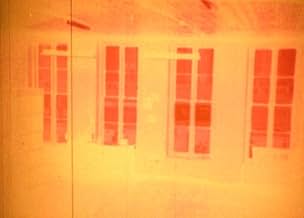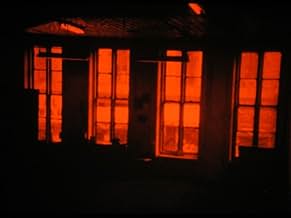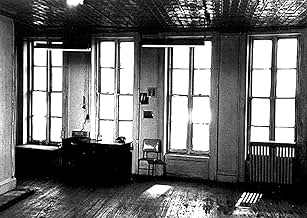NOTE IMDb
5,3/10
3,3 k
MA NOTE
Classique le plus original du cinéma expérimental jamais réalisé, Wavelength est un film de cinéma structurel qui consiste en un zoom avant de 45 minutes sur une fenêtre durant une semaine.Classique le plus original du cinéma expérimental jamais réalisé, Wavelength est un film de cinéma structurel qui consiste en un zoom avant de 45 minutes sur une fenêtre durant une semaine.Classique le plus original du cinéma expérimental jamais réalisé, Wavelength est un film de cinéma structurel qui consiste en un zoom avant de 45 minutes sur une fenêtre durant une semaine.
- Réalisation
- Scénario
- Casting principal
- Récompenses
- 1 victoire au total
Avis à la une
"Wavelength" is and will always be one of the most controversial films of experimental cinema: the type of film that you either despise it or you consider it a masterpiece. From the ratings and reviews on IMDb, it is evidently the former is definitely common among most cinema goers, those who criticize it as being "boring"' "drudgery", "annoying", "unbearable", etc. Frankly, those claims cannot be directly pushed aside due to the truth that is in them: yes, to some forty-five minutes of a single scene would be the most intolerable thing on earth; indeed, for those with sensitive hearing, the sound would be enough for anyone to tear their hair out. But that does not mean it's bad. On the contrary, I believe Michael Snow was not a horrible, untalented filmmaker that tried and backfired to please audiences when he made "Wavelength", but deliberately attempted to be unconventional, boring and downright irritating. This was not the only film to fall in such a genre either; there were actually quite a number of unpleasant avant-garde films made around the sixties period, some even worse, that were intended to challenge the viewer in their difficult aspects.
The forty-five minute long work is a single scene of a room, experimented with using various color filters, slowly and gradually zooming in to a photo on the wall of the room. Very little occurs onscreen except for the zoom, and in many ways it is really a series of film variations on the only focal point. That's not to say there is no onscreen action though; traffic can be seen occasionally moving outside the windows of the room, several women enter early on whilst a Beatles song is played, and the climax is a series of loud banging noises--as though a burglary is happening offscreen--before the great experimental filmmaker Hollis Frampton enters the shot and falls dead to the floor.
One other reviewer has interpreted that the film's goal is that to have almost nothing happen the viewer gets to appreciate more what does happen, and this is a very good point. In either case, it is a very interesting and abstract experimental work, as well as the ending which does a quite literal turn on the title, and an absolute must for fans of experimental cinema. It's boring only if you look at it as a scene of a room; it becomes interesting when you delight in the moments of action and I really liked it because it kept my interest despite the lack of events. I found that when watching it it was not a painfully boring watch like many say, because after a while you accept nothing big is going to happen and let the movie play out as it is. To be constantly bored at a movie for an entire forty-five minutes is quite unnatural, at least for me.
The forty-five minute long work is a single scene of a room, experimented with using various color filters, slowly and gradually zooming in to a photo on the wall of the room. Very little occurs onscreen except for the zoom, and in many ways it is really a series of film variations on the only focal point. That's not to say there is no onscreen action though; traffic can be seen occasionally moving outside the windows of the room, several women enter early on whilst a Beatles song is played, and the climax is a series of loud banging noises--as though a burglary is happening offscreen--before the great experimental filmmaker Hollis Frampton enters the shot and falls dead to the floor.
One other reviewer has interpreted that the film's goal is that to have almost nothing happen the viewer gets to appreciate more what does happen, and this is a very good point. In either case, it is a very interesting and abstract experimental work, as well as the ending which does a quite literal turn on the title, and an absolute must for fans of experimental cinema. It's boring only if you look at it as a scene of a room; it becomes interesting when you delight in the moments of action and I really liked it because it kept my interest despite the lack of events. I found that when watching it it was not a painfully boring watch like many say, because after a while you accept nothing big is going to happen and let the movie play out as it is. To be constantly bored at a movie for an entire forty-five minutes is quite unnatural, at least for me.
An acceptable thing to watch, so long as you turn the sound off. Just suffered it in the cinema in the basement and whilst the ideas behind it may or may not be interesting, I didn't have a chance to think further because of the boiling kettle. So watch it somewhere you have control of the volume and play some Rage Against The Machine over it. This may go completely against what the director intended, but what's he going to do about it? Boil another kettle at you?
Man, this guy really knows how to zoom and make noise at the same time! Although Avant-Garde filmmakers (and other artists alike) may find this an interesting way of using the medium, it's really nothing more than a cheap way of trying to be unique while keeping your technique as simple as possible. I had time to go out and get lunch (and eat it, mind you) before this dude was finished zooming into the picture. I'd like to hear the DVD commentary :)
Like others who've seen this film, I watched in film school. It's a one-gag joke that may seem boring but yet the film is unforgettable: A long, slow zoom through a window into a room, eventually closing up onto a picture of a wave.
During the painfully slow zoom things happen in the room, though it's never busy or plot-driven. The highlight for me was when someone snapped on a radio and the Beatles "Strawberry Fields" played. Was that an underhanded way of saying that the film was a bad LSD trip?
Beyond the Beatles, the soundtrack consists of a long, annoying, screeching crescendo. It's awful, but try as I could, I was unable to catch a short nap during the film because of the soundtrack. For that it earns my praise. I mean, if Hollywood can't keep me awake with their drivel, then this film deserves some kind of award.
During the painfully slow zoom things happen in the room, though it's never busy or plot-driven. The highlight for me was when someone snapped on a radio and the Beatles "Strawberry Fields" played. Was that an underhanded way of saying that the film was a bad LSD trip?
Beyond the Beatles, the soundtrack consists of a long, annoying, screeching crescendo. It's awful, but try as I could, I was unable to catch a short nap during the film because of the soundtrack. For that it earns my praise. I mean, if Hollywood can't keep me awake with their drivel, then this film deserves some kind of award.
Michael Snow's masterpiece, or something like that, is a "structural picture" from 1967 called Wavelength. Though the film was incredibly painful to my ears, it for some reason has stuck with me. After a long thinking period, I have decided that I actually really liked it.
At a little under 45 minutes long, Wavelength is not an easy film to get through. It features a non-moving camera set in a large room, and nothing else. The camera captured the action that goes on in the room to create what Snow calls "a summation of my nervous system, religious inklings and aesthetic ideas." On the surface it is merely a stiff frame of three walls, a floor and a ceiling with the occasional, but brief, interaction of a human variety. But once you look closer you will realize that your eyes have deceived you.
Through the entire film, Snow has his camera zooming in at an extremely slow speed. After realizing this, your eyes will be fixated on the screen in a desperate attempt to convince yourself that you are not insane. I found the entire concept to be so emotionally exhausting and frustrating that once the film was over I could do nothing but watch it again. It was a pleasantly unpleasing experience that did nothing but expand my conception of conventional filmmaking.
I have to admit that the soundtrack behind the film was a bit confusing for me. It was nonexistent for most of the film, but all of a sudden WHAM! Imagine the most ear-piercing scream or squeal that you have ever heard. Now combine them to make the last half an hour of Wavelength. I honestly thought that I was going to disturb my neighbor's dog with the high pitched whistles and unexplainable wails that accompanied the actionless action. If you can handle the sounds you will be rewarded by the film.
With Wavelength, Snow created the most aesthetically praised work in all of avant-garde. His technique ultimately forced me into a starring contest with the screen. It was me versus the structure of a single room. It was me versus the nonexistent, but ever present, movement of the camera's lenses. I waited arrogantly for the film to flinch. It never did. And then it ended.
At a little under 45 minutes long, Wavelength is not an easy film to get through. It features a non-moving camera set in a large room, and nothing else. The camera captured the action that goes on in the room to create what Snow calls "a summation of my nervous system, religious inklings and aesthetic ideas." On the surface it is merely a stiff frame of three walls, a floor and a ceiling with the occasional, but brief, interaction of a human variety. But once you look closer you will realize that your eyes have deceived you.
Through the entire film, Snow has his camera zooming in at an extremely slow speed. After realizing this, your eyes will be fixated on the screen in a desperate attempt to convince yourself that you are not insane. I found the entire concept to be so emotionally exhausting and frustrating that once the film was over I could do nothing but watch it again. It was a pleasantly unpleasing experience that did nothing but expand my conception of conventional filmmaking.
I have to admit that the soundtrack behind the film was a bit confusing for me. It was nonexistent for most of the film, but all of a sudden WHAM! Imagine the most ear-piercing scream or squeal that you have ever heard. Now combine them to make the last half an hour of Wavelength. I honestly thought that I was going to disturb my neighbor's dog with the high pitched whistles and unexplainable wails that accompanied the actionless action. If you can handle the sounds you will be rewarded by the film.
With Wavelength, Snow created the most aesthetically praised work in all of avant-garde. His technique ultimately forced me into a starring contest with the screen. It was me versus the structure of a single room. It was me versus the nonexistent, but ever present, movement of the camera's lenses. I waited arrogantly for the film to flinch. It never did. And then it ended.
Le saviez-vous
- AnecdotesMichael Snow has stated that his intent with the film was for it to be "a summation of my nervous system, religious inklings and aesthetic ideas."
- Citations
Woman in fur coat: I just got here, and there's a man lying on the floor, and I think he's dead.
- ConnexionsEdited into WVLNT: Wavelength For Those Who Don't Have The Time (2003)
Meilleurs choix
Connectez-vous pour évaluer et suivre la liste de favoris afin de recevoir des recommandations personnalisées
Détails
- Durée
- 45min
- Couleur
- Rapport de forme
- 1.37 : 1
Contribuer à cette page
Suggérer une modification ou ajouter du contenu manquant

















